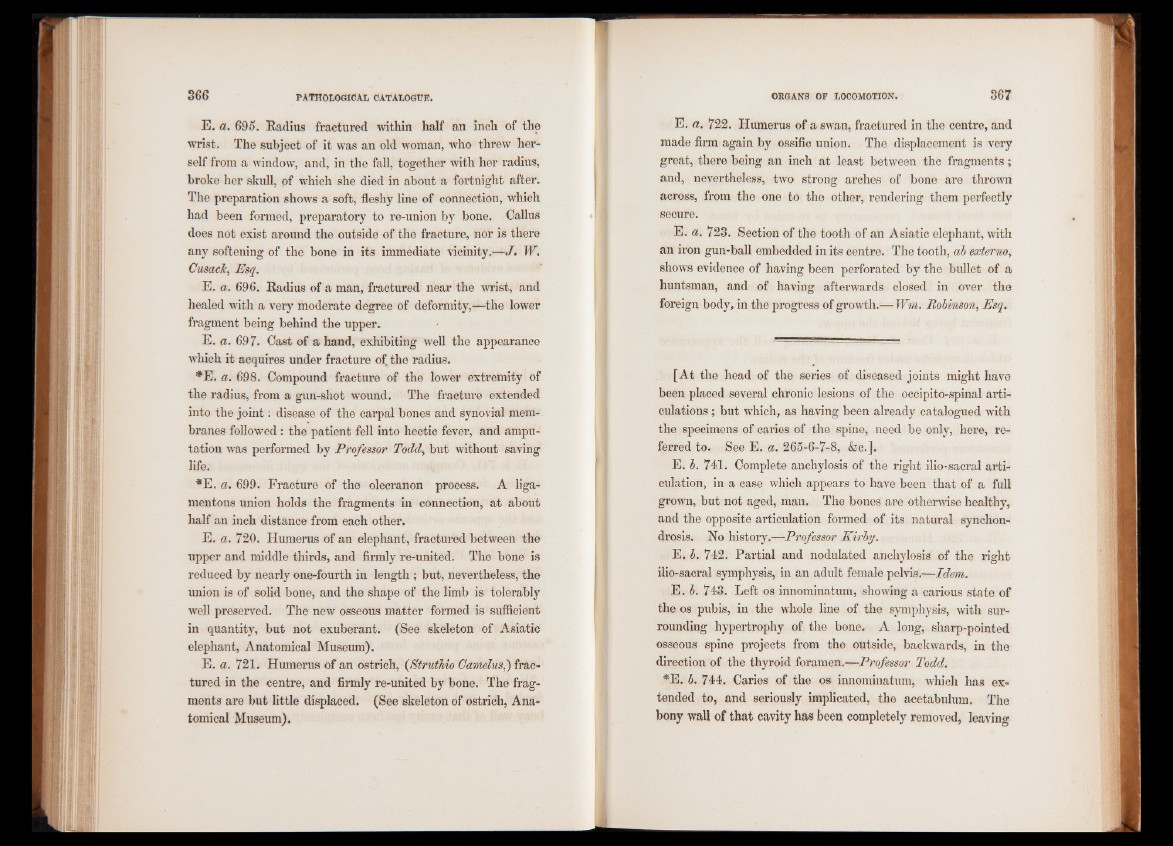
E. a. 695. Radius fractured within half an inch of the
wrist. The subject of it was an old woman, who threw herself
from a window, and, in the fall, together with her radius,
broke her skull, of which she died in about a fortnight after.
The preparation shows a soft, fleshy line of connection, which
had been formed, preparatory to re-union by bone. Callus
does not exist around the outside of the fracture, nor is there
any softening of the bone in its immediate vicinity.—J. W.
Cusack, Esq.
E. a. 696. Radius of a man, fractured near the wrist, and
healed with a very moderate degree of deformity,—the lower
fragment being behind the upper.
E. a. 697. Cast of a hand, exhibiting well the appearance
which it acquires under fracture of the radius.
#E. a. 698. Compound fracture of the lower extremity of
the radius, from a gun-shot wound. The fracture extended
into the joint: disease of the carpal bones and synovial membranes
followed : the patient fell into hectic fever, and amputation
was performed by Professor Todd, but without saving
life.
*E. a. 699. Fracture of the olecranon process. A ligamentous
union holds the fragments in connection, at about
half an inch distance from each other.
E. a. 720. Humerus of an elephant, fractured between the
upper and middle thirds, and firmly re-united. The bone is
reduced by nearly one-fourth in length ; but, nevertheless, the
union is of solid bone, and the shape of the limb is tolerably
well preserved. The new osseous matter formed is sufficient
in quantity, but not exuberant. (See skeleton of Asiatic
elephant, Anatomical Museum).
E. a. 721. Humerus of an ostrich, (StrutMo Camelus,) fractured
in the centre, and firmly re-united by bone. The fragments
are but little displaced. (See skeleton of ostrich, Anatomical
Museum).
E. a, 722. Humerus of a swan, fractured in the centre, and
made firm again by ossific union. The displacement is very
great, there being an inch at least between the fragments;
and, nevertheless, two strong arches of bone are thrown
across, from the one to the other, rendering them perfectly
secure.
E. a. 723. Section of the tooth of an Asiatic elephant, with
an iron gun-ball embedded in its centre. The tooth, ab externo,
shows evidence of having been perforated by the bullet of a
huntsman, and of having afterwards closed in over the
foreign body, in the progress of growth.— Wm. Robinson, Esq.
[At the head of the series of diseased joints might have
been placed several chronic lesions of the occipito-spinal articulations
; but which, as having been already catalogued with
the specimens of caries of the spine, need be only, here, referred
to. See E. a. 265-6-7-8, &c.].
E. b. 741. Complete anchylosis of the right ilio-sacral articulation,
in a case which appears to have been that of a full
grown, but not aged, man. The bones are otherwise healthy,
and the opposite articulation formed of its natural synchondrosis.
No history.—Professor K irby.
E. b. 742. Partial and nodulated anchylosis of the right
ilio-sacral symphysis, in an adult female pelvis.—Idem.
E. b. 743. Left os innominatum, showing a carious state of
the os pubis, in the whole line of the symphysis, with surrounding
hypertrophy of the bone. A long, sharp-pointed
osseous spine projects from the outside, backwards, in the
direction of the thyroid foramen.—Professor Todd.
*E. b. 744. Caries of the os innominatum, which has extended
to, and seriously implicated, the acetabulum. The
bony wall of that cavity has been completely removed, leaving